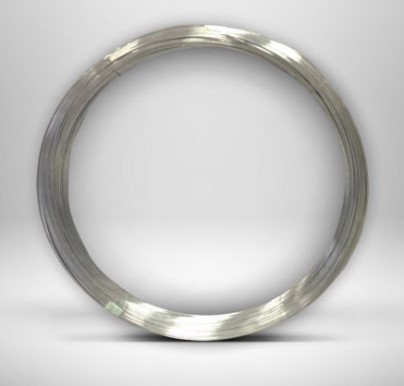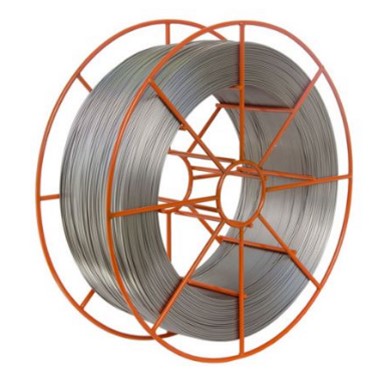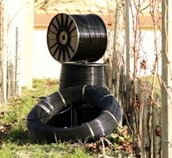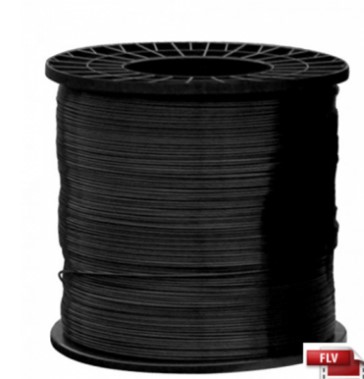How to choose the right trellising wire?
Winegrowing is a field that requires meticulous attention to every detail, including the choice of materials used to support the vines. Among these materials, trellis wire plays a crucial role in maintaining and growing vines. In this article, we'll explore the different types of trellis wire available on the market and provide practical advice on choosing the ideal trellis wire for your vineyard.
1. What are the criteria for choosing trellising wire?
Resistance to tension and corrosion
Trellising wire must be strong enough to support the weight of the vines and withstand the elements. Choose trellis wire with high tensile strength to avoid premature breakage. In addition, corrosion resistance is essential in a wine-growing environment where the wire is exposed to humidity and the chemicals used in vine treatment.
Thickness and flexibility
The right thickness of trellis wire is important to ensure adequate support for the vines. A wire that is too thin risks breaking under tension, while one that is too thick can damage the stems of the vines. Wire flexibility is also essential for easy vine shaping during pruning and maintenance.
Durability and longevity
Trellising wire is generally used over a long period of time, so it's crucial to choose a durable and resistant material. Winegrowers generally use galvanized wire and stainless steel. Galvanized wire is less expensive, but can corrode over time. Stainless steel is more expensive, but offers better corrosion resistance and a longer service life.
Cost and availability
The cost of trellis wire can vary depending on the material, quality and quantity required. It's important to evaluate value for money to find the wire that suits your budget while satisfying the requirements of your vineyard. You should also make sure that the trellising wire you choose is readily available, so that you can easily obtain it when you need it.
It's important to note that the choice of trellising wire will depend on your specific needs, such as local climate, vineyard characteristics and budget.
2. What are the different trellising wire materials?

Galvanized wire is one of the most common options because of its affordability. It is made from steel wire coated with a layer of zinc to protect it from corrosion. The advantages of galvanized wire include its strength and widespread availability. However, it does have some disadvantages, such as its relatively limited durability compared with other options, as the zinc coating can wear away over time, exposing the wire to corrosion.

Stainless steel wire is considered one of the most durable and corrosion-resistant options available on the market. It is made from high-grade stainless steel, giving it excellent resistance to the weather and chemicals used in viticulture. Advantages of this type of wire include longevity, corrosion resistance and high tensile strength. However, it is generally more expensive than galvanized wire.

Polyamide wire is a more recent alternative used in some wineries. Made from polyamide resin, it offers several advantages. Firstly, it's light, flexible and easy to handle, which facilitates installation and maintenance of the trellising system. What's more, it is UV, rot and corrosion resistant, giving it a longer lifespan than galvanized wire.

It has high tensile strength and is relatively light. It is resistant to weathering, rotting and corrosion. What's more, it has low elasticity, enabling the desired tension to be maintained to support the vines. However, it can be more expensive than other trellising wire options and requires special fasteners for installation.
Note that you can find this type of wire in small coils on the e-viti website.
3. Should different trellising wires be used for different purposes?
Different types of trellis wire are commonly used for different trellis functions. Here is an explanation of the roles and characteristics of the different types of trellising wire :
The support wire is generally the lower wire of the trellising system, attached close to the ground. Its main role is to support the weight of the vines and maintain their desired height. The supporting wire must be strong, resistant and capable of withstanding high tension to withstand the load of the vines. Galvanized steel or stainless steel wires are commonly used as support wires because of their strength and durability.
Lifter wires are positioned above the support wire and are used to help guide the vertical growth of the vines. They can be spaced at different heights to accompany the growth of branches and bunches. The lifting wires may be thinner than the supporting wire, but they still need to have a certain strength and flexibility to support the branches and bunches attached to them.
Anchoring wires are used to secure the trellising system to the anchoring posts. They are generally thicker and stronger than support or lifting wires. Anchor wires ensure the stability and strength of the entire trellising system. Larger-gauge galvanized or stainless steel wires are often used for anchor wires.
4. E-Viti tips for choosing the right trellising wire
The choice of trellising wire depends on the type of vine you grow and the trellising system you use. Vines can be trained in a variety of ways, such as V-shaped trellis training , guyot pruning, or espalier training for fruit trees. Each system requires specific trellising wire properties in terms of strength, flexibility and durability.
It is also advisable to choose trellising wire according to the climatic conditions in your region. In regions where humidity is high or frequent chemical treatments are necessary, it is preferable to choose a trellis wire that is resistant to corrosion. Stainless steel is a recommended option in these conditions, as it offers excellent corrosion resistance. If you opt for galvanized wire, make sure it has a high-quality zinc coating for better protection against corrosion. In regions with intense sunshine, it's essential to choose UV-resistant trellis wire. Polyethylene or polypropylene trellis wires often have increased resistance to UV rays, making them suitable for regions with intense sunshine.
Trellis wire can be repaired, but this will depend on the extent of the damage. In some cases, if the damage is too extensive or the wire too worn, it may be preferable to replace it entirely.
In conclusion, choosing the right trellis wire in viticulture is crucial to supporting healthy vine growth and ensuring the durability of the trellis system. Take into account the type of vine and trellising system, as well as your region's climatic conditions, including hailstorms, humidity, sunshine and corrosion, to choose the most appropriate trellising wire for your vineyard.



